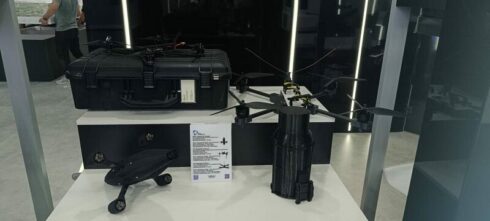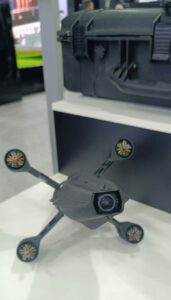At a major Russian tech expo, a new drone dubbed “Kinzhal” (Dagger) has burst onto the scene – literally. Unveiled at Innoprom-2025, this high-speed interceptor UAV is engineered to ram enemy drones out of the sky at 186 mph. With its origins in a collaborative Russian effort and a name shared with a hypersonic missile, the Kinzhal drone is poised to redefine drone warfare. Observers are already buzzing: Could this “drone assassin” tip the balance in Ukraine’s skies?
Background: ASF-Innovatsii and Its Allies
ASF-Innovations, a Moscow-based defense tech firm, unveiled its Kinzhal interceptor drone as part of Russia’s South Ural UAV cluster. Entirely domestically produced, its components include an airframe by Farmplast (specializing in advanced composites), electric motors by Pro-Technology, high-thrust propellers from Vector, and flight controllers by Krayt, optimized for high-speed stability. This all-Russian supply chain symbolizes Moscow’s push for self-reliance amid sanctions. ASF also showcased the Plamya-10 FPV kamikaze drone, but Kinzhal drew particular attention at Innoprom, praised as “fast and precise” for neutralizing enemy UAVs.
Design & Specs: A 300 km/h Drone “Missile”
At first glance, Russia’s Kinzhal drone resembles a compact missile more than a quadcopter. Its streamlined body with four rotors houses a mid-wave infrared (MWIR) seeker, enabling autonomous targeting via heat signatures. This fire-and-forget capability ensures effectiveness despite electronic jamming, needing no radio guidance in its final approach.
Kinzhal’s standout feature is its remarkable speed: officially reaching 300 km/h (186 mph)—twice as fast as typical FPV combat drones—making evasion nearly impossible for enemy UAVs. While precise details about range and endurance remain undisclosed, its small size and high speed suggest a short-range, short-duration interceptor, ideal for immediate low-altitude air defense scenarios.
Uniquely, Kinzhal employs direct kinetic impact—ramming enemy drones rather than using weapons. Its robust Farmplast frame and extreme speeds generate sufficient force to destroy small to medium UAVs upon collision, offering a cost-effective alternative to traditional anti-aircraft missiles. As Western analysts note, kinetic interceptors like Kinzhal provide affordable and practical solutions against UAV threats at the tactical level.
High-Speed Rivalry: Kinzhal vs. Red Bull’s Record FPV Drone
To grasp just how fast 300 km/h is for a drone, consider that it rivals the record-setting FPV racing drone built by Red Bull and the Dutch Drone Gods, which chased a Formula 1 car at over 350 km/h last year. That drone hit 300 km/h in just 4 seconds but drained its battery in about 3 minutes, with rotors spinning at an astonishing 42,000 RPM and Formula 1-level engineering support.
Red Bull Drone 1, a filming drone created by the Dutch company Drone Gods in collaboration with Red Bull, designed for broadcasting Formula 1 races
General layout of a turboprop drone
Red Bull Drone 1 in action
Russia’s Kinzhal drone, with its top speed of 300 km/h, achieves near-record performance using domestic components, likely with a similar endurance trade-off. Its streamlined, missile-like airframe reduces drag, and electric motors from Pro-Technology provide instant torque for rapid acceleration. While electric propulsion means brief, battery-intensive sprints, that perfectly suits its interceptor role—quick launches, fast target interception, no prolonged flight.
In short, Red Bull built a drone to film racecars; Russia built one just as fast to hunt enemy drones—highlighting how rapidly drone technology is evolving across both sports and military domains.
The Cost Question: How Much for a “Drone Killer”?
Russia hasn’t disclosed the Kinzhal UAV’s price, but we can estimate based on comparable systems. Drone interceptors dramatically improve cost-efficiency—firing a $400,000 missile to destroy a $20,000 drone makes little sense. Ukraine’s “Clear Sky” initiative demonstrated interceptors priced between $1,000-$5,000, notably cheaper than anti-air missiles ($400k+) or even Iranian Shahed drones ($20k-$30k each).
Kinzhal, with its advanced infrared seeker, custom airframe, and high-performance motors, likely costs tens of thousands—perhaps around $20k-$30k. This is still affordable compared to U.S. Coyote Block 2 interceptors ($15k-$20k) or Israeli Harop munitions ($70k+). Spending ~$25k per intercept remains cost-effective against expensive threats like cruise drones or swarms of loitering munitions.
Russian industry suggests domestic production further lowers costs through economies of scale and lower labor expenses. As Ukraine demonstrated, interceptor drones drastically reduce the “cost per shot,” flipping the economics of air defense to affordably counter drone swarms.
How Kinzhal Could Change the Game in Ukraine
The development of Russia’s Kinzhal interceptor drone stems directly from lessons learned in Ukraine, where UAVs dominate battlefield reconnaissance, artillery targeting, and loitering strikes. Traditional defenses struggle against these small, agile drones, leaving a gap interceptor drones aim to fill.
If fielded in Ukraine, Kinzhal could significantly alter combat dynamics:
Airspace Denial: Kinzhals stationed at key locations could quickly intercept Ukrainian reconnaissance or attack drones, creating no-fly zones and forcing caution from enemy UAV operators.
Rapid Engagement: At 300 km/h, Kinzhal covers 1 km in ~12 seconds, swiftly engaging threats. Its thermal seeker enables fast, reliable targeting even at night or against swarms, surpassing traditional defenses.
Recon & ISR Potential: While Kinzhal is designed as a “one-way” interceptor, similar drones could carry cameras for rapid reconnaissance, darting in and out of danger zones or escorting high-value UAVs—effectively acting as drone “bodyguards.”
Counter-Loitering Munitions: Kinzhal could counter persistent loitering threats, reversing Ukrainian tactics used against Russian drones, turning aerial combat into a cat-and-mouse chase.
Psychological & Strategic Impact: Successful interceptor deployment may force Ukraine to alter tactics (e.g., using decoy drones or saturation strikes). Confidence in drone defense could embolden Russian ground operations, though failures could also demoralize or drain resources.
Currently, Russia’s drone interceptors, including Kinzhal, remain prototypes or in limited testing, unlike Ukraine’s operational interceptor drones. Kinzhal’s introduction signals Moscow’s intent to rapidly close this capability gap.
As Zelensky recently noted, Ukrainian interceptors downed
“hundreds of enemy targets” within a week, underscoring their effectiveness. A successful Russian equivalent like Kinzhal could similarly reshape aerial warfare dynamics.
Expert Reactions and Military Implications
Military analysts are closely following “drone-on-drone” developments, viewing interceptors like Kinzhal as part of the growing trend of decentralized drone warfare, reshaping tactical air combat.
Experts highlight that the concept isn’t new—early U.S. experiments date back decades—but practical implementations emerged only in the 2010s. Raytheon’s Coyote, Anduril’s Anvil, Israel’s Harpy, and XTEND interceptors are notable examples, proving small drones can effectively neutralize aerial threats.
Electronic warfare (EW) is a key concern. While Kinzhal’s autonomous infrared seeker is resistant to RF jamming, its communications could still be disrupted, and IR seekers remain vulnerable to decoys like flares. Analysts speculate Russia may integrate counter-EW measures, hinted by experiments with fiber-optic tethers seen in other drones like Plamya-10.
Integration into air-defense networks is another challenge. Like Ukraine’s “Clear Sky” system, Russia must link Kinzhal to radar and acoustic sensors for timely launches, potentially incorporating AI-driven autonomy. Experts stress the importance of robust command-and-control to prevent friendly-fire incidents.
Ukraine’s widespread drone warfare (over 100 interceptions reported by July) suggests drone dogfights are now routine. Kinzhal, alongside Russian interceptors like “Yolka” and “Tarantul-Ptitselov,” reflects Russia’s rapid adaptation to Ukrainian innovations. Western analysts acknowledge the strategic value but question Russia’s ability to effectively scale and deploy these drones amid sanctions and operational realities.
Conclusion: The Future of High-Speed Drone Warfare
Russia’s Kinzhal interceptor drone represents a bold leap in drone warfare, combining high speed, autonomous guidance, and kinetic strikes—technologies barely imagined a few years ago. Its development by multiple small firms highlights Russia’s shift toward decentralized innovation.
If effective, Kinzhal could significantly bolster Russia’s air defenses, countering Ukraine’s drone tactics like reconnaissance and kamikaze attacks. Its deployment may lead militaries worldwide to adopt similar high-speed interceptors as standard equipment, prompting the creation of stealthier, faster drones and increasingly advanced countermeasures.
For now, Kinzhal employs a straightforward, forceful approach—using drones to kill drones—which demonstrates how the Ukraine conflict accelerates global military innovation.
MORE ON THE TOPIC:










how the fuck are ratheon and lockheed supposed to deliver plus 10% revenue earnings growth to their shareholders making $20,000 drones?
organ trade, child trafficking and all black book degeneracy makes up for idiotic toy projects.
you are right. one f-35 cost the same as 5000 combat drones. so math is simply: produce 500 000 drones and doing attack not by 100s but by 20 000s drones at once.
gli americani devono dire ai loro amici europei di calmarsi e fare pressioni per trattare è loro non devono occuparsi degli altri stati ma pensare a casa propria, intanto l’ucraina si becca 3 piccole bombe atomiche e la partita è scacco all’occidente.
what’s needed are starlink-killer systems that give the locations of the terminals so drones so that it’s a death sentence being near one
time for another massive penetration of moscow!
ehheehhe